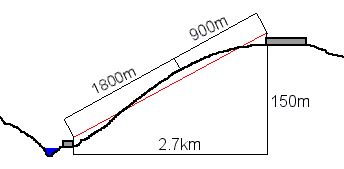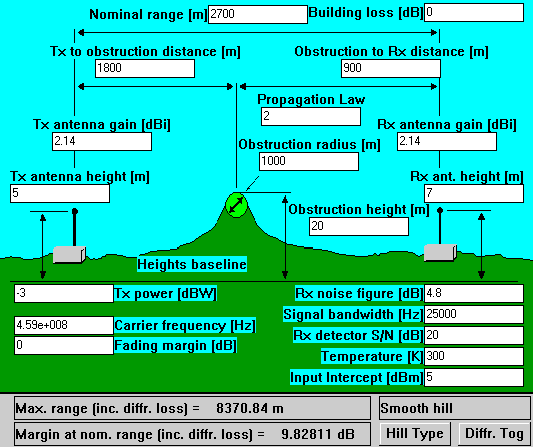|
Before we start; The law is sometimes a little vague and other times very clear. When it comes to Effective Radiated Power (ERP) it is usually the latter being extremely clear about the maximum allowed power to be fed into an antenna of a specified maximum gain. Here, my rebellious side will most decidedly, although I feel justifiably, shine through! The aim is to point out some of the failings that exist as a result of abiding by the law and how careful planning can benefit both the authorities and you as the user. This policy is more related to Low Power Radio (LPR), however, the same arguments can be used on licensed systems with an aim to achieving the same purpose. Note, I am not advocating that you deliberately break the law and put your licence and/or installation at risk. LPR systems vary in power from about 10mW to roughly 500mW. For the sake of starting somewhere we'll be using the higher power of 500mW but the same principles can be adopted to the lower powers with the figures calculated as required. Let's begin our argument with a power monitoring scheme with signals fed from a number of electrical sub stations situated in relatively flat terrain. For the sake of simplicity we'll also have the host station situated in the middle with the sub stations around the perimeter of the area the stations serve. The law is clear in that 500mW is the highest ERP permitted, and we are using devices with no means of reducing the output power of the transmitter. This forces us into a situation where the highest gain permitted is 0dB i.e. no gain at all otherwise we would be exceeding ERP limits. 500mW in anybody's language is a fair amount of power. If you have a hard time believing this try using the formula (well known to all radio enthusiasts) to calculate the distance the signal will travel in free space: D = alog((10log(P) - S - 20log(F) - 2.45) / 20) where: From this we see the signal is capable of being received at -97.5dBm (3ÁV) at 75km Line Of Sight (LOS), without difficulty! This formula does not, however, include the gains of the antennas used in the installation and is thus modified to: D = alog((10*log(P)) - S + Gt + Gr - (20*log(F) - 2.45) where: By adding just a 3dB antenna to each end our original path is now doubled to 150km. It is not surprising that the 500mW limit imposed on licence free devices is ERP and not power output! It must be remembered the above formula is for line of sight i.e. there is nothing between the transmitter and receiver. This formula is only good where the transmitter and receiver can 'see' each other such as mountain top to mountain top. There is one factor that usually limits how far the signal will travel between two sites being the curvature of the Earth. We can use the following formula to determine the distance of the 'Attainable LOS', otherwise known as 'Radio Horizon': D = 4.1( where: In flat terrain with antennas mounted at 5m we would probably get about 10km. You will also have noticed there is no mention of power and sensitivity in this formula. Although transmit power and receive sensitivity do affect the distance, it takes enormous amounts of power to increase a small distance once beyond this horizon. As our installation is over a flat area and signal strengths are not proving a problem we settle for 0dB 'end-fed' dipoles. This appears to be an ideal picture but things change radically when asked to install a new system nearby. After a short while we realize the first system is interfering with the new one, and we are having to dodge calls from the first client who's long working, reliable system is now falling over. What is adding insult to injury is this all happened while abiding by the law! What has happening is, although such LPR systems have a fairly limited range as can be seen by the formula for radio horizon, an oversight came when thought was given to the distance between the two hosts. In our example we will call it 20km. According to the formula there is just no way these two stations will communicate with one another. But this is not the problem. Although the host's radio horizon is a radius of 10km the system as a whole occupies a radius of up to 20km. This is owing to the equivalent horizon radius at the outstations. We could move frequency but this could be a very short term solution as someone else could move in on our channel (remember, it is a licence free band). The alternative is to keep all the radiated energy from our sub stations limited towards the direction of the relevant host. This would prevent the outstations affecting the second system. But such focusing brings with it an undesired effect, gain! In order to reduce the radiation in the unwanted directions we would require about 6dB minimum of gain (and some clever design) to achieve in excess of 20dB 'off beam' attenuation. |
|
|
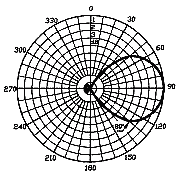
|
|
An example of such an antenna is shown together with the radiation pattern. Note the grid reflector. The thought of 6dB gain with the ERP now at 2 watts! (4 times what is allowed) will prompt a visit from the local radio authority. Personally, this is regarded as an overreaction. What has not been considered yet is the losses that exist in most installations. With only a 10m length of RG213 and 2dB is already lost (5m alone would be used up the mast). We then have connectors, lightning protection, and the high possibility that the output from the transmitter is not quite at full throttle. With all this added in we suddenly find that, if we're fortunate, only 3dB is truly realised. Ok, I know, that's still 1W ERP but look at how considerate you've been keeping the airwaves as uncluttered as possible. This fact alone is more likely to prevent rather than promote a visit from those boys of the radio regulators. Let's change the situation for a slightly more realistic terrain, and include a water reservoir fitted with a level gauge linked by radio to a pumphouse in a valley below. Let's, however, revert back to our 0dB omni-directional antennas and put ourselves on top of a 150m (500ft) mountain. Suddenly, even with the curvature of the earth to contend with, we have a LOS probability, in other words a radio horizon, in excess of 50km! So here we are, shouting out our existence on the top of this lonely mountain, not just to the pumphouse down in the valley below, but to everywhere within a possible 50km radius. How many other LPR sites are there likely to be in this vicinity? Taking this argument further how many other such sites are we interfering with and, worse still, how many of these are interfering with us!? The apparent answer, as shown above, is to use a directional antenna. This way we ensure we only send our radio waves down the mountain to the intended recipient, the pumphouse securely nestled in the trees on the bank of the river in the valley below. Sounds idyllic, doesn't it? Unfortunately the coffee is about to kick in and spoil your dream.
As previously pointed out, in order to focus the energy into one direction we automatically create gain in the antenna system. Even tighter focusing will be required than in the previous example which translates into higher gain than before. You may have heard it is possible to focus without creating gain but such antenna systems are usually inefficient and therefore affect the receive performance - why settle for second best? What is the alternative? Apart from using a directional antenna, there isn't one. However, if using a directional antenna is pursued then choosing the correct sort of antenna is a vital requirement.
So, facing down the mountain to our pumphouse is our 500mW fed into a 12dB antenna with the ERP at 8 watts which is enough to make our signal capable of travelling 300km! The question needs to be asked "are we doing any harm?". Yes, in both of these examples the law is being broken, but that wasn't the question, was it? Before we can answer we need to define the word "harm". We are only concerned with sites on the same frequency, any stations not on the same frequency will never be affected by our mountain top site. Let's first consider any stations out of the beamwidth of the antenna i.e. anything at approximately 20 degrees off centre where the signal has reduced to 0dB. Any sites that are within 'earshot' of this mountain will obviously hear this station, but then how often is it transmitting? Probably not a lot. Anything out of the 20 degree window is probably not even going to know of this station's existence, let alone be bothered by it. Now to consider stations within the 'firing line' of our 12dB Yagi. As previously said, the chances of having another user on your working frequency is fairly slim but if you do the interference will be in both directions, you are going to receive their signals when they transmit, and likewise, they will receive yours when you transmit. Let's deal with a rather rare occurrence first but one that none-the-less needs to be considered. Should a co-user of the frequency be sending and receiving a high amount of data they are not only going to cause you a lot of interference but they too are going to notice your site when it does its rare transmissions. The reason for this is every time your mountain-top site transmits, even though it is seldom, you disturb their transmissions. If they are using law abiding antennas they will have a good case against you. The only advice here is to monitor the frequency very carefully before putting this sort of installation together, and then to periodically check no-one has moved in! Back to a bit of reality. The chances are, should there be a co-user on your frequency, they too are simply monitoring the level of a water system, turning a pump on when required, etc. i.e. the channel usage is low. In order for both to be 'happy campers' on the frequency the amount of radio traffic must be kept to a minimum and one way to do this is to ensure the command gets through first time. Having marginal radio comms on either system is not going to help either of you as there are likely to be repeat transmissions to get the command through. Am I advocating your co-user also have a decent antenna system? You bet ya!
Have a look at the sample profile above showing our reservoir and pumphouse, the profile is drawn for clarity and not to scale. At first it may appear fine but upon closer investigation you will notice, using the red line drawn in as a guide, the gentle slope of the mountain is actually blocking the radio path. This sample profile was drawn from a recent survey conducted therefore such instances do exist. Shown below is the radio path profile using our well-loved RFProp.
What will be noticed from the above screenshot is the figure "9.88dB margin". At first glance this appears to be a workable situation but upon closer investigation this site is doomed to failure for at least some time of the year, and it's going to be a time when site visits are unpleasant - cloudy, rainy weather. The reason for this is during this time there is a high possibility that mist and rain will degrade the signal. Further to this the ground gets wet making it more 'radio absorbent' thus adding to the degradation. Long term research has proven that at UHF at least a 20dB 'fade margin' should be built into the equation. In our case we are a whole 10 dB short of that target. What is also not added into the above equation is any losses on the antenna coax leads etc. If fitted with a 0dB dipole then during wet weather this site would be desperately trying to get data through to its mate in the valley but, as it's not, all of the re-transmissions will achieve nothing more than interfering with other mountain top sites within 50km. Adding the 12dB Yagi to the system will not only ensure our yelling mountain top is only heard along a fairly narrow path being the beamwidth of the antenna but also only as often as it is required to yell i.e. every piece of data it passes to the pumphouse will be heard the first time, and interference kept to a minimum. Conclusions: If fitting a directional antenna is, however, legitimately done to reduce 'radio clutter', by concentrating the radiated energy to the direction required, or by reducing interference through the message getting through first time every time, then I would personally do it. Reducing radio clutter scores a huge big 'Yes' with me. Also, we have proven that the curvature of the earth and general terrain is the biggest headache when it comes to getting data from site A to site B, but in this case it can also be a friend. Remember, it was the the curvature and terrain that gave you the headache in the first place, all that's been achieved is the signal will be heard just a little further. | | Ask a Question | 03.11.00 |
|
 Omni vs Directional Gain
Omni vs Directional Gain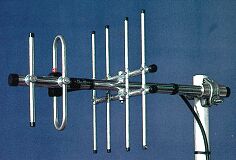

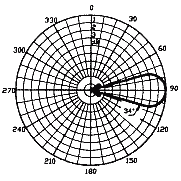 Pictured is a superb phased dual driven element Yagi exhibiting a fairly narrow beamwidth, the radiation pattern shown alongside. Although this antenna has a gain as high as 12dB resulting in an ERP of 8 watts, put another way your signal can travel 4 times further!, this can only happen off the front of the antenna. Off the sides of the antenna the performance is drastically reduced, and it does not take much veering from the centre to return to 0dB gain. In fact, by increasing the angle a slight bit more the performance is so reduced that we are now radiating even less than out of the original dipole.
Pictured is a superb phased dual driven element Yagi exhibiting a fairly narrow beamwidth, the radiation pattern shown alongside. Although this antenna has a gain as high as 12dB resulting in an ERP of 8 watts, put another way your signal can travel 4 times further!, this can only happen off the front of the antenna. Off the sides of the antenna the performance is drastically reduced, and it does not take much veering from the centre to return to 0dB gain. In fact, by increasing the angle a slight bit more the performance is so reduced that we are now radiating even less than out of the original dipole.